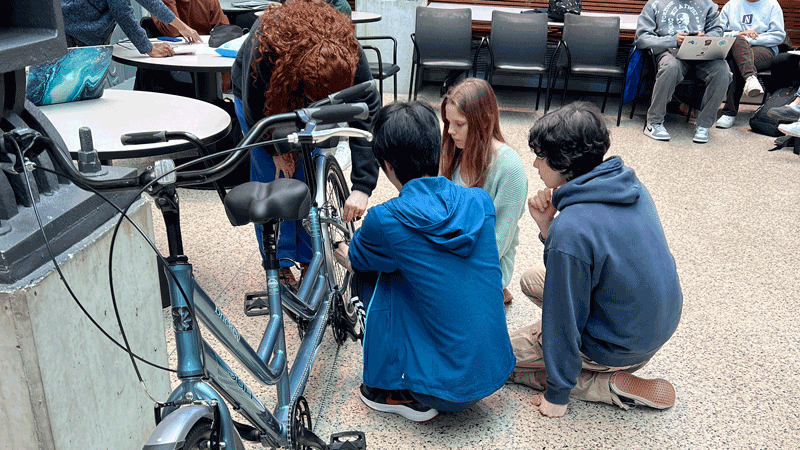Cycling Success
DTC student teams work to improve Envision Unlimited’s adaptive cycling program.

Amelia Hasting ('27), an applied mathematics major, will never look at a tandem bike the same way again.
Hasting’s revised outlook is the result of her recent experience in Design Thinking and Communication (DTC), a required two-quarter sequence for all first-year Northwestern Engineering students in which they work alongside community partners to create practical solutions for real-world problems. DTC is taught jointly by faculty in the Segal Design Institute and Weinberg College of Arts and Sciences Cook Family Writing Program.
Earlier this year, Hasting and 15 of her peers worked with Envision Unlimited, a Chicago-based nonprofit serving adults with intellectual and developmental disabilities, on a project to improve the usability of tandem bikes in the organization’s adaptive cycling program.
“The project forced us to ask a lot of questions, really dive into the details, and work together to understand how we could create something tangible to help Envision Unlimited and its riders,” said Hasting.
Understanding the problem
Envision Unlimited’s adaptive cycling program affords its participants a regular opportunity to interact with the community, build relationships, explore, and heighten independence.
Yet in its current fleet of 30 tandem bikes, Envision Unlimited program coordinator David Pufundt noticed the kickstands were prone to failure and user error. Convinced a more intuitive, easy-to-use kickstand would benefit riders and create a more enjoyable experience, he turned to DTC students to create a more natural, functional option.
In an introductory meeting with DTC students and instructors Zachary Berent and Ignatius Aloysius, Pufundt and three of the cycling program’s participants visited campus with a tandem bike. They met with DTC students and detailed Envision Unlimited’s program and noted the different pain points the ineffective kickstands created.
Immediately, Pufundt, in his first time partnering with DTC, was impressed by the students’ earnest attention and thoughtful questions.
“It was clear the students had a desire to provide us with something that was going to benefit us,” Pufundt said.
Embracing the process
Thereafter, four teams of four students fueled by curiosity and empathy dove into the design process. They studied the tandem bike, assessing its differences from the traditional single-rider bicycle, and joined an Envision Unlimited group ride to observe participants. They took videos, pictures, and measurements. They asked more questions and collected more information.

Students then used their background research to ideate potential solutions. They created mock-ups and prototypes, later presenting their ideas to Pufundt and Envision Unlimited participants for additional feedback.
As teams zeroed in on a solution, they again met with Envision Unlimited stakeholders for feedback before moving toward final design. They ordered materials, experimented with different variations, and worked alongside professionals in the Ford Prototyping Shop to finalize their prototypes. In March, students produced final reports detailing their design process and presented their prototypes to Envision Unlimited partners and others at the DTC Project Expo.
Mutual benefits
To improve Envision Unlimited’s tandem bikes, Hasting and her team Spring Kickstand — including Elsie Hayduk, David Kovach-Fuentes, and Alvin Xu — found inspiration in another two-wheeled mode of transportation: the motorcycle.
Knowing motorcycle kickstands must be more robust to handle the vehicle’s weight, the Spring Kickstand team investigated different properties of that solution and ordered one online. The tested different attachment mechanisms, modifications, and placement before arriving at a solution maintaining structural integrity while avoiding rider interference.
“The way our message and our information were respected and turned into something tangible was really special,” Pufundt said. “DTC students brought perspective that we didn’t have and that perspective led to the kickstands, led to the storage ideas, and those will benefit us on every ride we take moving forward.”
For Hasting, working with Envision Unlimited proved an incredibly valuable experience demonstrating the value of teamwork, compromise, and looking at multiple angles of a problem, even one as seemingly minor as a bicycle kickstand.
“It’s the end result that matters, and you want to help people,” Hasting said.
For the first-year engineering students, Berent said DTC provides a window into life as a professional engineer. The experience underscores the human-centered design mindset, creative problem-solving, and soft skills, namely listening and communication, vital to life as an engineer.
“While in an academic context, the DTC sequence helps students see what life will be like as an engineer,” he said. “It’s an early example of how they might attack problems and work with others to develop practical solutions.”
